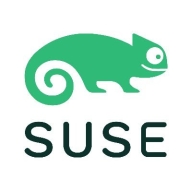

SUSE Linux Enterprise and Micrium OS compete in operating systems, with SUSE leveraging enterprise features and Micrium OS focusing on embedded systems and real-time applications. SUSE holds the upper hand in enterprise support and scalability, whereas Micrium stands out for its specialized functionalities in specific markets.
Features: SUSE Linux Enterprise provides advanced security, robust performance, and superior scalability, catering to large enterprises seeking comprehensive solutions. Micrium OS focuses on efficient resource utilization, real-time response, and a design tailored for embedded systems, aligning with niche applications that prioritize speed and precision.
Ease of Deployment and Customer Service: SUSE Linux Enterprise offers seamless deployment and integration supported by an extensive customer service infrastructure, appealing to large organizations needing reliable assistance. Micrium OS, while straightforward to deploy, may require specialized support due to its embedded orientation, highlighting a contrast in service needs.
Pricing and ROI: SUSE Linux Enterprise generally involves higher initial costs reflecting its extensive features and services, leading to significant long-term ROI for enterprise environments. Micrium OS provides cost-effective solutions for budget-focused projects in embedded systems. Despite cost variations, SUSE's potential for long-term ROI through scalability and security presents vital benefits for enterprises willing to invest.

Micrium OS stands out in the embedded systems landscape for its versatility, reliability, and top-tier performance, making it a go-to solution across various industries. It shines in high-stakes environments such as medical instruments, automotive systems, consumer electronics, and industrial controls, showcasing its prowess in delivering precise, dependable operations essential in these sectors. Users laud Micrium OS for its stellar reliability, ensuring stable system functions critical for sensitive applications. Its efficiency maximizes system resource utilization, and its real-time performance is unmatched, catering to needs for timely task execution. The OS's ease of integration, flexible architecture, and detailed documentation further elevate its user appeal.
Adopting Micrium OS has led organizations to witness marked improvements in efficiency and productivity, streamlining workflows and fostering better collaboration. Its seamless compatibility with existing systems offers a smooth transition, minimizing the learning curve and hastening operational speed while reducing errors. The OS's customization capabilities allow it to meet specific needs, enhancing departmental performance and contributing to significant cost savings. Collectively, these attributes demonstrate Micrium OS as a comprehensive, efficient, and reliable choice for embedded system development, driving positive outcomes in organizational performance and goal achievement.
SUSE Linux Enterprise offers features like YaST for server management, seamless integration with Oracle and SAP, and a robust security setup. Renowned for stability, it efficiently supports workstations, SAP workloads, and cloud migrations across diverse industries.
SUSE Linux Enterprise is known for its lightweight design, high performance, and ease of installation. Its flexible architecture supports extensive documentation and efficient patching. The system uses the BTRFS file system for effective virtualization, and community support is significant. However, challenges include package updates causing conflicts, difficult initial setup and software management, high pricing, and support response times. Improvements in security compliance, cloud integration, hardware compatibility, and documentation are also needed.
What are SUSE Linux Enterprise's important features?
What benefits should users expect from using SUSE Linux Enterprise?
Industries like healthcare and banking use SUSE Linux Enterprise for secure transactions and structured application deployment. It is also a choice for organizations involved in testing, automation, and web development, offering support for SAP HANA integration and facilitating cloud migrations.
We monitor all IoT Operating Systems (OS) reviews to prevent fraudulent reviews and keep review quality high. We do not post reviews by company employees or direct competitors. We validate each review for authenticity via cross-reference with LinkedIn, and personal follow-up with the reviewer when necessary.